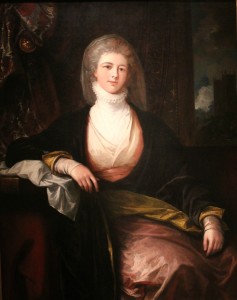By Kathleen Storey, Marketing Intern

Benjamin West (American, 1738 - 1820), The Honorable Mrs. Shute Barrington, 1808, oil on canvas, 50 1/8 x 40 3/16 in., Museum Purchase, AP.1960.2.1.

Benjamin West (American, 1738 - 1820), Angels appearing to the Shepherds, c. 1790, oil on canvas, 25 ½ x 20 ¼ in., Purchased with funds from the Morton R. Hirschberg Bequest and a gift from Diane DeMell Jacobsen, Ph.D., in loving memory of her husband, Thomas H. Jacobsen, AP.2006.11.1. Photograph courtesy of Brian Shrum.
Benjamin West was an Anglo-American painter of historical scenes around the time of the American Revolution. Not only was he an extremely gifted painter, he was also the second president of the Royal Academy of Arts in London serving from 1792 to 1820. Born on October 10, 1738 in Springfield, PA, West learned about paint at a young age. When he was a very young child, Native Americans showed him how to mix paint with clay from the river bank and bear grease. From there, he became sufficiently self-taught.
During the years of 1746 to 1759, West worked in Pennsylvania painting portraits. In 1756, a friend of West encouraged him to paint the “Death of Socrates,” based off an engraving in Charles Rollins’ Ancient History. The finished product, which is vastly different from his other works, has been praised as “the most ambitious and interesting painting produced in colonial America.”
In 17563, West moved west to England. Here, he was commissioned by King George III to create portraits of the royal family. In 1770, he painted what is considered his most famous piece, The Death of General Wolfe, which later became one of the most reproduced images of the period.
Along with Sir Joshua Reynolds, West founded the Royal Academy of Arts in 1768. Reynolds was the first president, while West became the second president in 1792. In 1806 he was re-elected president and served until his death in 1820.
West spent the remainder of his life in London. During this time, King George appointed him historical painter to the court, he was Surveyor of the King’s Pictures, and many famous American artists studied under him, including Rembrandt Peale, Thomas Sully and John Trumbull.
Benjamin West is a great American painter. Known for his wonderfully colorful and expressive representations of thrilling moments in history, West’s work has a way of bringing his art to life in a way that makes the viewer easily identify with the scene at hand.


